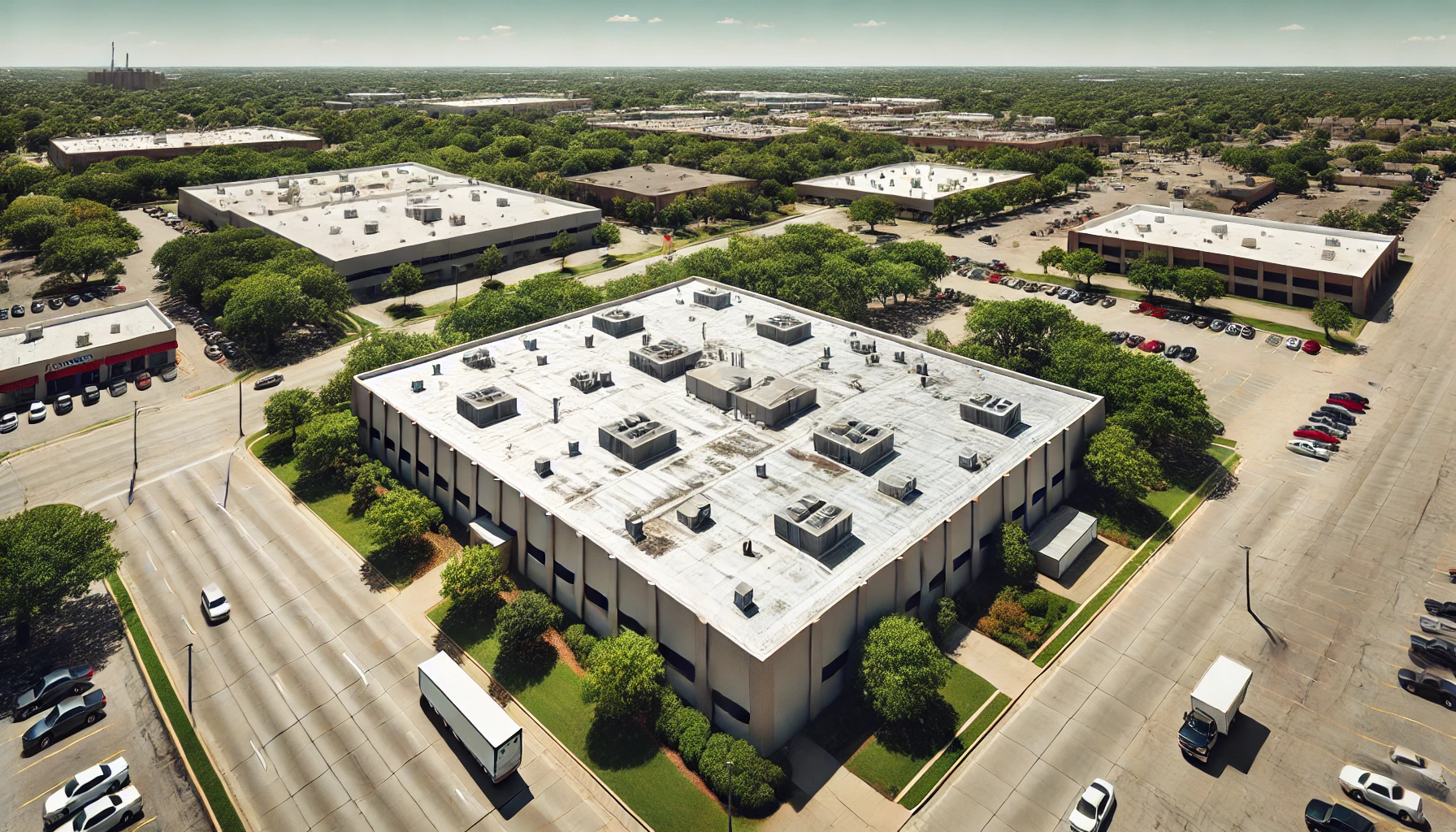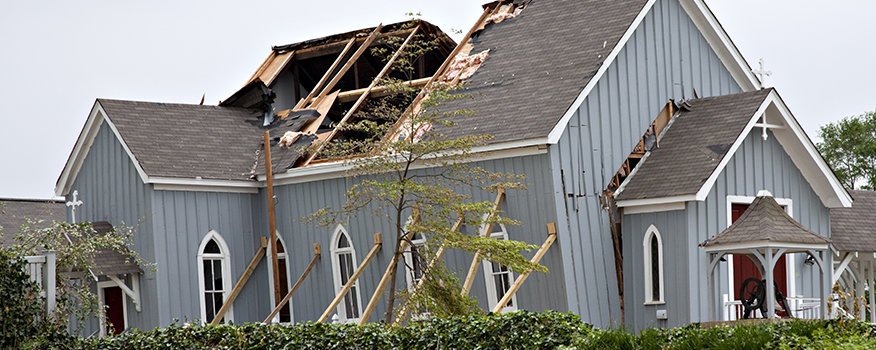Flat roofs are a common feature on commercial buildings across Wichita and surrounding areas like Derby and Newton. While these roofs are known for their durability, they are not immune to the challenges posed by Kansas’s unpredictable weather—think heavy rains, hailstorms, and the intense summer sun. As a commercial building owner, recognizing the signs that it’s time to replace your flat roof is crucial. Timely roof replacement can save you from costly repairs, improve energy efficiency, and prevent potential safety hazards. Here are the top five signs that indicate it’s time to consider a flat roof replacement in Wichita.
- Key Takeaways
- 1. Persistent Leaks and Water Damage
- 2. Visible Damage and Aging
- 3. Rising Energy Bills
- 4. Structural Problems and Sagging Roof
- 5. Frequent Repairs and High Maintenance Costs
- Conclusion
- FAQs for Flat Roof Replacement in Wichita
- How do I know if my flat roof needs to be replaced or just repaired?
- What are the most common signs of damage on a flat roof?
- How long does a typical flat roof last?
- How can replacing my flat roof help reduce energy bills?
- What should I do if I notice my flat roof is sagging?
- Can I continue to operate my business during a flat roof replacement?
- How much does a flat roof replacement typically cost in Wichita?
Key Takeaways
- Persistent Leaks: Frequent and widespread leaks in a flat roof are strong indicators that it may need replacement. Addressing leaks promptly can prevent extensive water damage and costly repairs.
- Visible Damage and Aging: Signs of aging, such as cracks, blisters, and tears in the roofing material, suggest that a flat roof is nearing the end of its lifespan. Replacing the roof before damage worsens is crucial for maintaining building integrity.
- Rising Energy Bills: An aging flat roof with compromised insulation can lead to increased energy costs as HVAC systems work harder to maintain temperature control. Replacing the roof with modern, energy-efficient materials can significantly lower energy bills.
- Structural Problems and Sagging: A sagging roof is a serious safety concern that may indicate weakened structural support due to water damage or debris. Immediate replacement is necessary to prevent potential roof collapse and ensure occupant safety.
- Frequent Repairs: When the cost and frequency of roof repairs begin to outweigh the benefits, it’s often more economical and practical to replace the entire roof. A new roof reduces maintenance needs and minimizes business disruptions.
1. Persistent Leaks and Water Damage
One of the clearest indicators that your flat roof may need replacing is the presence of persistent leaks. Flat roofs, by design, have minimal slopes, which makes them more prone to water pooling. Over time, this pooling can lead to leaks that seep through the roof, causing damage to the building’s interior and structure.
Consider a scenario where a Wichita-based business owner notices small leaks during a rainy spell. Initially, these leaks seem minor, and quick patches seem to solve the problem. However, as the rainy season progresses, the leaks become more frequent and widespread, leading to water-stained ceilings, mold growth, and even damage to the building’s electrical systems. These issues can disrupt daily operations, causing significant inconvenience and financial loss.
In such cases, frequent patchwork repairs might provide temporary relief, but they don’t address the underlying problem. If leaks are persistent and spread across multiple areas of the roof, it’s a clear sign that your roof has reached the end of its lifespan. A full roof replacement is often the best course of action to protect your building from further damage and avoid costly repairs down the line.
2. Visible Damage and Aging
Visible damage is another major sign that it’s time to replace your flat roof. Over time, exposure to the elements causes wear and tear on roofing materials. Signs of aging and damage, such as cracks, blisters, and tears, aren’t just cosmetic issues—they’re red flags that your roof may no longer be able to protect your building effectively.
In Wichita, where temperature fluctuations are common, roofing materials can expand and contract, leading to the formation of cracks. For example, EPDM (Ethylene Propylene Diene Monomer) roofs, a popular choice for flat roofs, may develop blisters due to trapped moisture. Similarly, TPO (Thermoplastic Olefin) roofs might show signs of surface degradation after years of exposure to UV rays.
Imagine a retail store owner in Newton who notices bubbling and cracking on their roof after a particularly harsh winter. Despite attempts to patch these issues, the damage worsens, eventually leading to a leak during a summer storm. The store owner then realizes that the roof is beyond repair and opts for a full replacement. This proactive decision not only restores the building’s integrity but also prevents further business disruptions.
Visible damage, especially when widespread, is a strong indicator that your flat roof is aging and needs replacement. Addressing these issues promptly can save you from unexpected emergencies and ensure the long-term safety of your property.
3. Rising Energy Bills
Have you noticed a steady increase in your energy bills? Your flat roof might be to blame. As roofs age, their insulation properties often decline, leading to higher energy consumption. In Wichita’s climate—characterized by hot summers and cold winters—an inefficient roof can force your HVAC systems to work overtime, driving up energy costs.
A well-insulated roof acts as a barrier, keeping your building cool in the summer and warm in the winter. However, as insulation materials deteriorate or become compromised due to roof damage, this barrier weakens. The result is heat loss during the winter and heat gain during the summer, both of which can significantly impact your energy bills.
Consider this scenario: A small office in Derby notices that their energy bills have been gradually increasing over the past few years. After investigating various potential causes, they discover that the insulation in their flat roof has deteriorated, allowing heat to escape during the winter and enter during the summer. They decide to replace the roof with modern materials that offer superior insulation. The result? A significant reduction in energy costs and a more comfortable working environment for employees.
If you’re experiencing rising energy bills, it might be time to have your flat roof inspected. A roof replacement with modern, energy-efficient materials can improve insulation, lower energy costs, and contribute to a greener, more sustainable operation.
4. Structural Problems and Sagging Roof
Structural integrity is crucial when it comes to the safety of your building. If you notice signs of structural problems, such as a sagging roof, it’s a clear indication that your flat roof may need to be replaced. Sagging often results from water damage that has weakened the roof’s support structure or from the weight of accumulated debris and standing water.
In severe cases, a sagging roof can lead to a partial or complete collapse, posing serious safety risks to anyone inside the building. This is especially concerning in commercial spaces where the safety of employees and customers is a top priority.
Imagine a manufacturing facility in Wichita that starts to notice a dip in the center of their flat roof. Initially, the owners dismiss it as minor settling. However, after a heavy snowstorm, the sagging becomes more pronounced, and water begins to pool in the sunken area. Realizing the danger of a potential collapse, the owners immediately call in a roofing expert, who recommends a complete roof replacement to restore the building’s structural integrity.
Structural problems, particularly sagging, should never be ignored. Regular inspections, especially after severe weather events, can help catch these issues early and prevent catastrophic failure. If your roof shows signs of sagging, it’s essential to consult a professional and consider replacing the roof to ensure the safety of your building and its occupants.
5. Frequent Repairs and High Maintenance Costs
If you’re constantly dealing with roof repairs and maintenance issues, it might be time to replace your flat roof. While minor repairs are expected over the lifespan of a roof, frequent issues indicate that the roof has reached a point where it can no longer function effectively.
Consider the cumulative cost of ongoing repairs. For example, if you’re spending thousands of dollars each year to patch up leaks, fix cracks, and address insulation problems, you’re likely approaching—or have surpassed—the cost of a full roof replacement. Additionally, frequent repairs can disrupt your business operations, causing downtime and frustration.
Take the example of a Wichita warehouse owner who has spent the last few years patching up various issues with their aging flat roof. Despite these efforts, new problems continue to arise, and the costs are adding up. After reviewing the maintenance records, the owner realizes that they’ve spent more on repairs than it would cost to replace the roof entirely. They decide to invest in a new roof, which not only eliminates the recurring issues but also provides peace of mind for the future.
When repairs become frequent and costly, it’s often more economical to replace the roof altogether. A new roof will reduce maintenance needs, minimize disruptions, and provide long-term protection for your building.
Conclusion
Recognizing the signs that your flat roof needs replacement is crucial for maintaining the safety, efficiency, and value of your commercial property. Persistent leaks, visible damage, rising energy bills, structural problems, and frequent repairs are all indicators that it’s time to consider a flat roof replacement in Wichita.
If you’ve noticed any of these signs, don’t wait for the problems to escalate. Proactive roof replacement can save you from costly repairs, improve your building’s energy efficiency, and ensure the safety of everyone inside. For reliable flat roof replacement in Wichita, trust Solid Rock Commercial Roofing to protect your investment and keep your building safe. Contact us today to schedule a professional roof inspection and explore your options for a new, durable, and energy-efficient roof.
FAQs for Flat Roof Replacement in Wichita
How do I know if my flat roof needs to be replaced or just repaired?
If your flat roof has persistent leaks, visible damage such as cracks or blisters, structural problems like sagging, or if you’re facing frequent and costly repairs, it’s likely time for a full roof replacement. A professional inspection can help determine whether repairs are sufficient or if a replacement is necessary.
What are the most common signs of damage on a flat roof?
Common signs of damage include leaks, water stains on ceilings, visible cracks or blisters in the roofing material, sagging areas, and rising energy bills due to poor insulation. These signs indicate that the roof may no longer provide adequate protection and might need replacement.
How long does a typical flat roof last?
The lifespan of a flat roof varies depending on the materials used and environmental factors. On average, a flat roof can last between 15 to 25 years. Regular maintenance and timely repairs can help extend its life, but eventually, replacement will be necessary as the roof ages.
How can replacing my flat roof help reduce energy bills?
Over time, the insulation in a flat roof can degrade, leading to higher energy costs as your HVAC system works harder to maintain comfortable temperatures. A new roof with modern, energy-efficient insulation can help regulate indoor temperatures more effectively, reducing your energy consumption and lowering utility bills.
What should I do if I notice my flat roof is sagging?
Sagging is a serious issue that suggests structural damage, possibly due to water accumulation or weakened support beams. If you notice any sagging, it’s crucial to contact a roofing professional immediately. They can assess the extent of the damage and recommend whether a roof replacement is necessary to prevent further risks, including potential roof collapse.
Can I continue to operate my business during a flat roof replacement?
In most cases, businesses can continue to operate during a flat roof replacement, though there may be some disruptions depending on the scope of the work. It’s best to discuss the project timeline and potential impacts with your roofing contractor to plan accordingly and minimize interruptions to your business operations.
How much does a flat roof replacement typically cost in Wichita?
The cost of a flat roof replacement can vary based on factors such as the size of the roof, the materials chosen, and the complexity of the project. It’s best to get a detailed estimate from a reputable roofing contractor in Wichita who can provide an accurate quote based on your specific needs.
This article is a collaboration between Solid Rock Commercial Roofing and OpenAI’s ChatGPT. Created on August 15, 2024, it combines AI-generated draft material with Solid Rock’s expert revision and oversight, ensuring accuracy and relevance while addressing any AI limitations.




